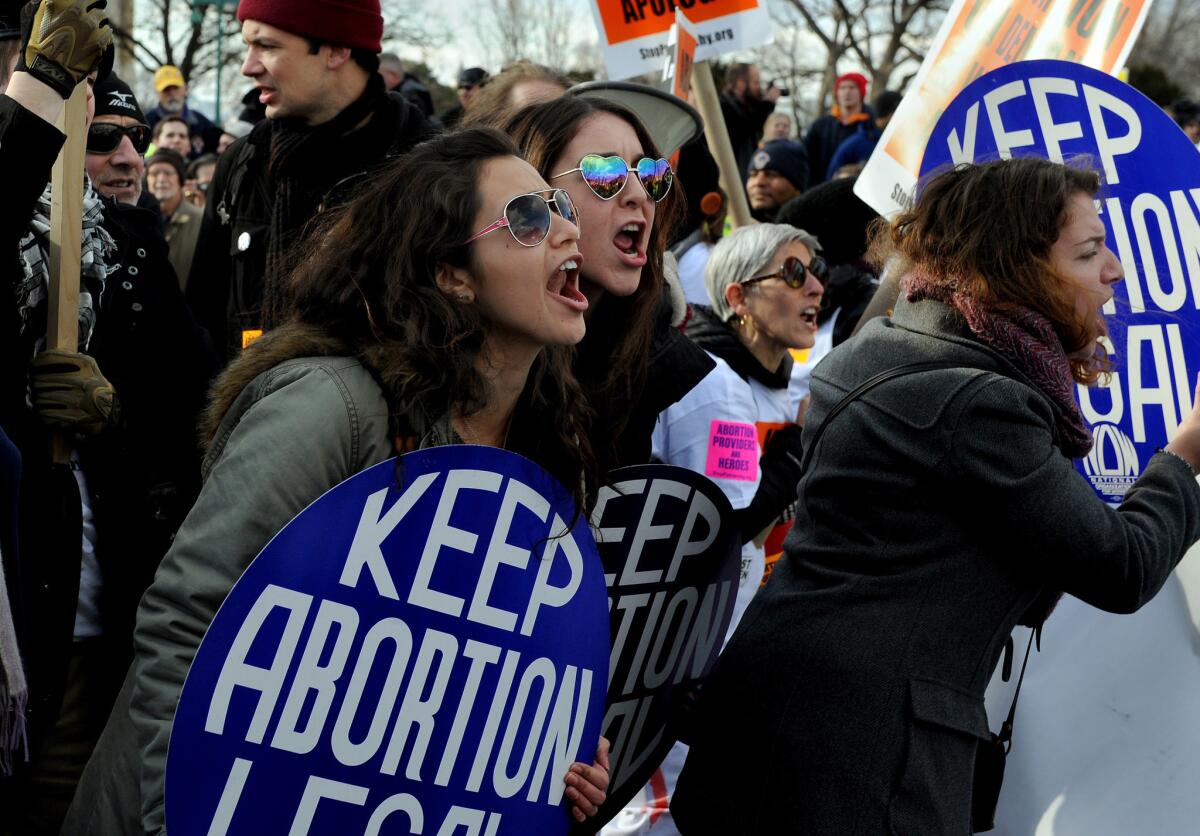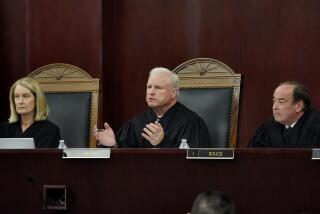Why liberals fear new Supreme Court term could hurt abortion rights and unions

Thousands of anti-abortion protestors and abortion supporters rallied on the mall and marched up to the Supreme Court to show their displeasure with the Roe V Wade decision.
Reporting from Washington — After legalizing same-sex marriage and upholding provisions of President Obama’s legacy healthcare program for a second time, the Supreme Court justices return to work Monday in a new term that will put liberals on the defense.
If the five conservative justices prevail in the year ahead, they could deal a severe blow to labor unions, rein in abortion rights under Roe vs. Wade, restrict college affirmative-action programs and shift political power away from Democratic-controlled election districts by redefining who gets counted as an eligible voter.
Predicting the outcomes is always tricky because of the close ideological split on the high court. In the last term, for example, Justice Anthony M. Kennedy and Chief Justice John G. Roberts Jr. voted with the the liberals in several major cases.
But the conservatives are poised to make major changes in the law if they can hold the majority.
Here are the five most politically charged issues facing the court this term.
Union fees: Can school teachers and other public employees in California, Illinois and about 20 states be required to pay union fees, even if they do not support it?
The court in 1977 upheld these mandatory fees on the grounds the unions are required to represent all the workers, so all should pay their fair share. However, the justices also said dissenting employees need not pay for a union’s political spending.
Justice Samuel Alito has raised free-speech questions about this arrangement, at least for public employees. He says the 1st Amendment forbids the government from forcing people to support causes or groups they oppose. Spurred by Alito, the court agreed to hear an appeal filed on behalf of Rebecca Friedrichs, an Orange County teacher, who objects to supporting the California Teachers Assn. She says the full dues amount to about $1,000 a year, and non-members like her have to pay about $650.
In recent years, Republican governors in Wisconsin and Michigan have won repeals of laws that required all workers to support their unions. If the court rules for Friedrichs, its decision could strike down those remaining laws in other states.
Election districts: Should states use Census data to draw election districts or switch to counting only the adult citizens who are eligible to vote?
The case of Evenwel vs. Abbott is this term’s most important election-law dispute because it could shift political clout within states and cities.
The Constitution says seats in Congress should be divided up based on “counting the whole number of persons in each state.” But the court in the 1960s said states must draw equal-sized districts based on the principle of “one person, one vote.”
The new challenge argues the states may count only citizens who can vote. If the court agrees, “it would amount to a redistricting revolution. Just about every districting plan in America would be unconstitutional and would have to be redrawn,” said Nicholas Stephanopolous, a University of Chicago law professor.
Lawyers for Los Angeles, Chicago and other big cities urged the court to keep the current system of counting all people. “With 15 million residents, Los Angeles County and Cook County are the two largest counties in the United States, comprising about 5% of the U.S. population, more than the total population of the 13 smallest states,” they told the court.
They said these cities stand to lose the most if the court changes the system for drawing districts because many of their residents are immigrants and non-citizens who are not able to vote. If large cities lose some of their representation and political power shifts to rural areas, it would put “strains on the already-limited local resources in the very places they are most urgently needed.”
NEWSLETTER: Get the day’s top headlines from Times Editor Davan Maharaj >>
Affirmative action: May a state university give a preference to qualified black and Latino applicants, or does such a “race conscious” admissions policy violate the equal-protection right of a white applicant?
Two years ago, the court faced that question in the case of Fisher vs. University of Texas. In a surprise, the justices did not decide the case, but instead told a lower court to take another, skeptical look at the university’s claim it needed a “race-conscious admissions” policy. Thanks to the state’s so-called “Top Ten” law, more than one-fourth of the freshmen at the Austin campus were Latino or black. They were admitted after having earned the top grades in their high school class.
But the lower court again upheld the Texas policy of admitting some students based on their race, and the justices voted to hear the case again. The outcome now appears to depend entirely on Kennedy. His four more conservative colleagues reject the use of race by schools and public agencies. If Kennedy joins them, they could rule narrowly against the Texas policy or more broadly against the use of affirmative action in admissions.
Abortion: How far may states go in regulating abortion clinics?
Texas, Mississippi and other states want to impose strict new regulations on abortion clinics that will have the effect of closing down most or all of them. They include requirements that clinic doctors have admitting privileges at a local hospital and their buildings meet the standards of an outpatient surgical center.
Lower courts are split over whether these regulations can be upheld as efforts to protect the health of women. Abortion-rights advocates say the regulations are “shams” designed to shut down the clinics and deny women access to abortion.
The justices blocked the Texas law from taking full effect, and they will decide in the fall whether to rule on the issue. If they do so, said the ACLU’s Jennifer Dalven, “it will be the most important abortion case since Casey,” when the court in 1992 last upheld the right to abortion set in Roe vs. Wade. The justices said then states may not put an “undue burden” on women who seek an abortion.
Religious liberties: Are religious colleges and nonprofits exempt from contraceptives mandates under the Affordable Care Act?
Dozens of religious colleges and Catholic nonprofit groups refuse to cooperate in any way with the Obama administration’s regulation that says female employees must be offered birth control drugs at no cost as part of their health insurance. The administration says that while these religious groups need not pay for this coverage, they must notify the government in writing of their decision to opt out. That would trigger their insurance provider to step in and offer the coverage.
Unswayed, Catholic leaders say even the notification action makes them “complicit” in supplying “abortion-inducing drugs” and thereby violates their religious beliefs.
The court is considering several appeals, including one from the Catholic Archdiocese in Washington, and it’s likely to decide on hearing one of the cases to decide the issue.
On Twitter: @DavidGSavage
ALSO
Marco Rubio, surging in the polls, draws attacks from onetime mentor Jeb Bush
Clinton to unveil new gun measures, sharpening contrast with Sanders and GOP
‘Daddy, he began to shoot’: A daughter’s account of Oregon rampage
More to Read
Sign up for Essential California
The most important California stories and recommendations in your inbox every morning.
You may occasionally receive promotional content from the Los Angeles Times.











